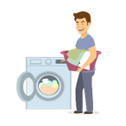Fleas are the most common cause of skin disease in our pets. Unfortunately, fleas are an environmental problem, with only 5% of the entire population the adult fleas which live on and feed off your pet. The other 95% live in the surrounding environment, making treatment very difficult! Fortunately, if you understand the flea lifecycle and stay committed to resolving the infestation a good outcome can be achieved.
Understanding the flea lifecycle:
Adults – Once on your pet, adult fleas spend the rest of their lives there, feeding and laying eggs. Female fleas lay eggs on your pet and can produce 40 to 50 eggs a day, beginning almost immediately for up to 60 days, leaving them to fall off your pet all over your home.
Eggs – Eggs represent about one-half of the entire flea population and are slightly smaller than a grain of sand. Each egg can hatch into larvae in 1 day when conditions are warm and humid, and as many as 30% will develop into adults.
Larva – These move away from light deep into your pet’s bedding and your carpets. They feed on flea dirt produced by adult fleas and other organic material. There are three different larval stages that may be completed in 5 days when conditions are warm and humid.
Pupae – Larva spin a cocoon and pupae develop into adult fleas inside. Fully formed adult fleas can survive in the cocoon for up to 6 months waiting for outside conditions to improve. They emerge to warm ambient temperatures, high humidity, together with vibrations and carbon dioxide emitted from a passing animal.
It is important to recognise that once there is evidence of fleas being present on your pet that the environment it lives in is now contaminated. This is a result of the prolific ability of fleas to reproduce, releasing hundreds of new eggs daily, falling off your pet onto its surroundings. Use a product such as Moxiclear on your pet that is fast acting and works by coming in contact with fleas. By not requiring the flea to bite and have a blood meal, this limits further irritation to your pet as well as stopping environmental flea egg contamination.

Breaking the environmental lifecycle will take up to 3 months
Breaking the flea lifecycle



